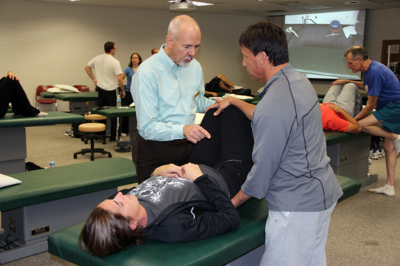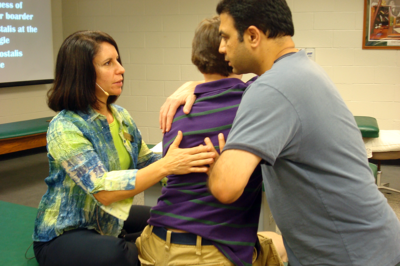The System
Analyze | Restore | Retrain | Integrate
Are you looking to develop more specific, effective, and easily adaptable exercise programs for your patients that get results?
With over 60 years of combined clinical experience, we have created a system that will allow the practitioner to identify dysfunctional movement patterns in the upper and lower quarter and find the underlying cause of compensation and chronic musculoskeletal dysfunction. Designed to complement the osteopathic biomechanical model we help you make the links between faulty patterns, mechanical dysfunction, muscle inhibition, and hypertonicity. Once identified, we give you effective manual therapy solutions and exercise prescription strategies that help improve clinical outcomes and get faster results.
Analyze
Identify faulty movement patterns and make the links to determine the most effective manual treatments and exercise prescription.
Restore
Select manual therapy treatments and exercises that quickly restore mobility and change the neural input to muscle pathways.
Retrain
Activate inhibited muscles and retrain movements to reinforce manual treatments once mobility is restored.
Integrate
Integrate movement patterns with functional activities to create long term carryover.
The History and Development
The System started with the Exercise Prescription course, which was first developed by Mark Bookhout, PT in 1992 as a complement to the CME courses being taught at the Osteopathic College at Michigan State University in East Lansing, MI. Mark had attended all of the courses that were being offered through the CME program at MSU and was asked to join the teaching faculty as an adjunct associate professor in 1987. He quickly identified that there was not an exercise component presented in any of the courses at MSU and was a much-needed addition.
 In Mark’s clinical experience, he found that his patients were much better able to maintain their improvements after his manual therapy treatment if they were given a specific home exercise program to address their dysfunctional biomechanics and movement patterns.
In Mark’s clinical experience, he found that his patients were much better able to maintain their improvements after his manual therapy treatment if they were given a specific home exercise program to address their dysfunctional biomechanics and movement patterns.
During a co-treatment session with Dr. Philip Greenman, D.O. at MSU, Mark introduced the concept of the pelvic clock to help diagnose and treat spinal dysfunction through a home exercise prescription, and the Exercise course was quickly born. Dr. Greenman asked Mark to develop an Exercise Course to complement the other manual therapy courses being offered through the CME program at MSU. Mark collated the information and designed an Exercise course in 1992 to complement the osteopathic biomechanical model which would help clinicians make the links between faulty movement patterns, mechanical dysfunction, muscle inhibition, and hypertonicity. The end result provided clinicians with the most effective manual therapy solutions and exercise prescription strategies that improved clinical outcomes and got faster results.
In designing the Exercise Course, Mark was greatly influenced by the work of Dr. Vladimir Janda whom he had first met in 1983 at the North American Academy of Manipulative Medicine in Alexandria, Virginia. Inspired by Dr. Janda and then approached by Dr. John Boudillon, who was also on the teaching faculty at MSU at that time, he wrote two chapters on exercise that were published in Dr. Bourdillon 5th Edition of Spinal Manipulation published in 1992. In 2019 Mark retired from teaching and practicing as a physical therapist, but the Exercise Course continues to be updated and taught at MSU, led by Lisa Chase and her colleagues. The Exercise course is also offered through Bookhout Seminars and The Back 2 Normal Institute.
 Lisa Chase joined the MSU faculty in 1998 and began teaching the Exercise Course with Mark in 2003 and over the years assisted in updating and advancing the Exercise course. In 2015 Mark and Lisa were appointed as Co-Chairs for the MSU Certification program for Functional Manual Medicine. They oversaw and facilitated the certification program and conducted onsite practical exams for the Exercise portion of the exam. In 2012 Lisa and Mark started Rehab Links where they expanded the resources for the Exercise Course by offering a unique, web-based health and fitness software program for the pro-active health care provider of manual therapy and exercise or fitness professional who wants to interact with their clients and provide them with state-of-the-art home exercise programs. In 2020 they set out to implement a clinically-based on-line training program for therapists to learn how to integrate the movement tests and the most effective manual therapy treatments and home exercise prescriptions.
Lisa Chase joined the MSU faculty in 1998 and began teaching the Exercise Course with Mark in 2003 and over the years assisted in updating and advancing the Exercise course. In 2015 Mark and Lisa were appointed as Co-Chairs for the MSU Certification program for Functional Manual Medicine. They oversaw and facilitated the certification program and conducted onsite practical exams for the Exercise portion of the exam. In 2012 Lisa and Mark started Rehab Links where they expanded the resources for the Exercise Course by offering a unique, web-based health and fitness software program for the pro-active health care provider of manual therapy and exercise or fitness professional who wants to interact with their clients and provide them with state-of-the-art home exercise programs. In 2020 they set out to implement a clinically-based on-line training program for therapists to learn how to integrate the movement tests and the most effective manual therapy treatments and home exercise prescriptions.
